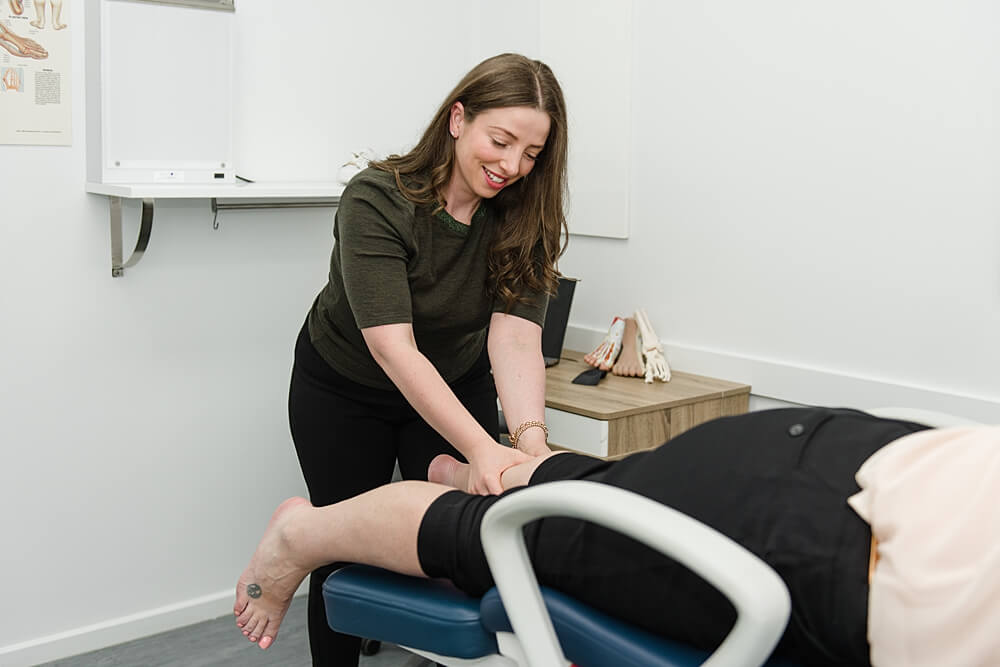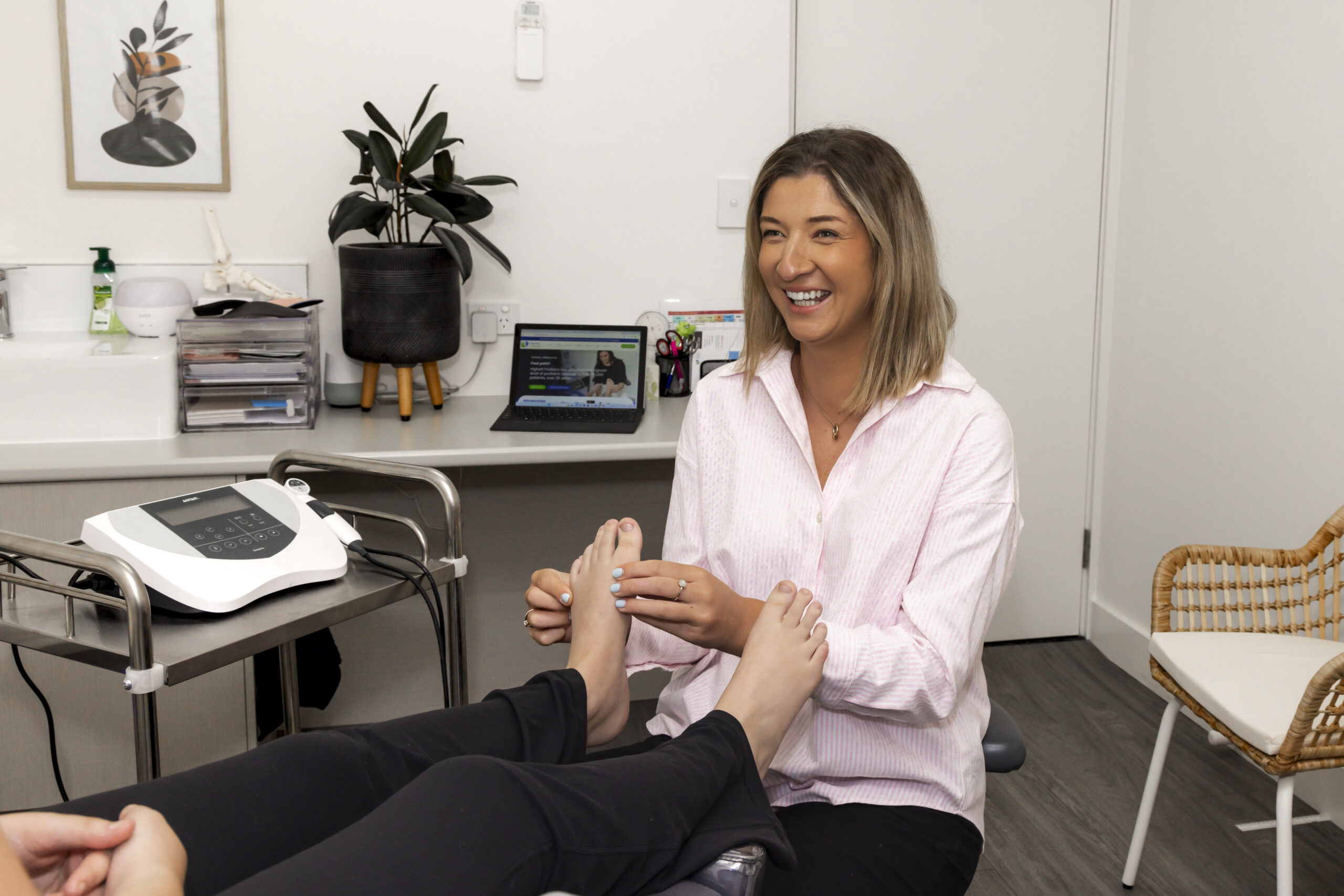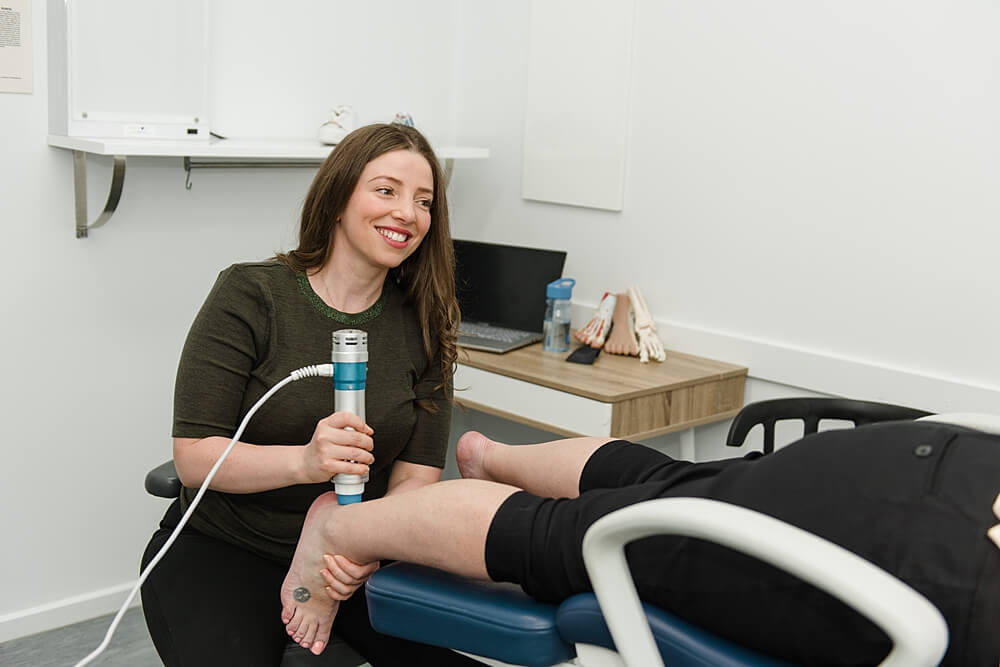Plantar Fasciitis Treatment
What is Plantar Fasciitis?
Plantar Fasciitis can also be known as Heel Spur Syndrome, “Policeman’s heel” or “jogger’s heel.”
Plantar Fasciitis is the Latin term for “inflammation of the plantar fascia”.
The plantar fascia is a thick, fibrous ligament that runs under the foot from the heel bone to the toes. It forms the arch of the foot and functions as our natural shock-absorbing mechanism. Unlike muscle tissue, the plantar fascia is not very elastic and therefore is very limited in its capacity to stretch or elongate.
When too much traction is placed on the plantar fascia (for various reasons) micro-tearing will occur, resulting in irritation, inflammation and pain.
Plantar Fasciitis usually causes pain under the heel. However some people may experience pain under the arch of the foot. Both heel pain and arch discomfort are related to Plantar Fasciitis, with heel pain being far more common than arch pain.


What is a Heel Spur?
After diagnosis of Plantar Fasciitis, you may be required to have an X-Ray taken. A heel spur will show clearly on an X-Ray of your foot. Calcaneal spurs are not painful. Pain is only caused because of inflammation of the tissue surrounding the heel spur.
Many who suffer from Plantar Fasciitis do not have a heel spur and vice-versa, those with heel spurs don’t always have painful feet. Spurs take many years to develop, they can also be found underneath the heel bone and also at the back of the heel (near the Achilles Tendon) or in other parts of the body.
What does Plantar Fasciitis Feels Like?
After walking around for a while, the ligament warms up, becomes more flexible, eliminating the pain or becoming more of a dull ache. After walking a long distance or standing for hours the pain is likely to return.
What causes Plantar Fasciitis?
Different contributing factors can overstretch the plantar fascia ligament under the foot including:
- Overuse – Activities that involve a lot of running or jumping, or standing for long periods of time, can put excessive stress on the plantar fascia, leading to micro-tears and inflammation.
- Weight gain – excess weight places great pressure on the bones, nerves, muscles and ligaments in the feet, leading to inflammation and pain. Often common in pregnancy.
- Age – As we age, the plantar fascia can become weaker and more susceptible to injury. Aging can also lead to a loss of flexibility and elasticity in the foot, which can exacerbate Plantar Fasciitis symptoms.
- Unsupportive footwear– Wearing shoes with poor arch support, inadequate cushioning, or that are too tight can put unnecessary stress on the plantar fascia, leading to injury and inflammation.
- Walking barefoot – Walking barefoot or wearing unsupportive shoes, such as flip-flops or sandals, can place additional strain on the plantar fascia and lead to injury, especially on hard surfaces like concrete or tiles.
- Low arch/flat feet/overpronation – Low arches or flat feet, as well as overpronation (when the foot rolls inward excessively during walking or running), can lead to excessive strain on the plantar fascia. Wearing shoes with proper arch support or using orthotic inserts can help prevent Plantar Fasciitis in those with flat feet or overpronation.
Treatment Options for Plantar Fasciitis?
Stretching – Stretching exercises can help to reduce tension in the plantar fascia and promote healing. Be careful that you only stretch your calf. Avoid stretching the foot as this will delay healing.
Anti-inflammatories – Non-steroidal anti-inflammatory drugs (NSAIDs) can help to reduce pain and inflammation in the affected area. These medications can be helpful in managing the symptoms of plantar fasciitis. Check with your pharmacist before beginning treatment.
Strapping – Strapping the affected foot can help to provide support and reduce tension on the plantar fascia. This can help to alleviate pain and promote healing.
CLICK HERE for our strapping video
Ultrasound – Ultrasound therapy can help to reduce inflammation and promote healing in the affected area. It works by using high-frequency sound waves to stimulate circulation and promote tissue repair.
Shock wave therapy – Shock wave therapy is a non-invasive treatment that uses high-energy sound waves to promote healing in the affected area. This treatment has been shown to be effective in reducing pain and improving function in patients with plantar fasciitis.


Anti-inflammatories – Non-steroidal anti-inflammatory drugs (NSAIDs) can help to reduce pain and inflammation in the affected area. These medications can be helpful in managing the symptoms of plantar fasciitis. Check with your pharmacist before beginning treatment.
Orthotic Therapy – Can help offload and support the heel and improve long term foot mechanics.
Footwear – Wearing appropriate footwear can help to reduce strain on the plantar fascia and promote healing. Shoes with good arch support and cushioning can be helpful in managing the symptoms of plantar fasciitis.
Injection Therapy – Corticosteroid injections can be used to reduce inflammation and relieve pain in the affected area. While this treatment can be effective in managing the symptoms of plantar fasciitis, it should be used with caution as repeated injections can lead to tissue damage.
Rest and ice treatment – are often recommended as short-term treatment. Plantar fasciitis is a condition that causes pain and inflammation in the plantar fascia, a band of tissue that runs along the bottom of the foot. Resting the foot and applying ice can help reduce pain and swelling.
Signs and Symptoms
The signs and symptoms of Plantar Fasciitis include:
- Pain in the heel or arch of the foot, typically felt in the morning or after long periods of inactivity.
- Stiffness or tightness in the bottom of the foot.
- Pain that worsens after standing or walking for prolonged periods.
- Tenderness or soreness in the bottom of the foot, particularly near the heel.
- Aching or burning sensations in the foot.
- Swelling or inflammation in the foot, although this is less common.
- Difficulty walking or standing for long periods of time.
If you experience any of these symptoms, it is important to consult with a healthcare professional to determine the cause of your pain and develop an appropriate treatment plan.
FAQ's About Plantar Fasciitis
How is Plantar Fasciitis diagnosed?
Can Plantar Fasciitis be prevented?
How long does it take to get rid of plantar fasciitis?
Do I need to stop exercising to fix my plantar fasciitis?
Can I just get a cortisone injection to fix my plantar fasciitis?
Are heel spurs painful?
Do night splints work for plantar fasciitis?
Does being overweight cause plantar fasciitis?
Always Consult A Trained Professional
The information in this resource is general in nature and is only intended to provide a summary of the subject matter covered. It is not a substitute for medical advice and you should always consult a trained professional practising in the area of medicine in relation to any injury or condition. You use or rely on information in this resource at your own risk and no party involved in the production of this resource accepts any responsibility for the information contained within it or your use of that information.
